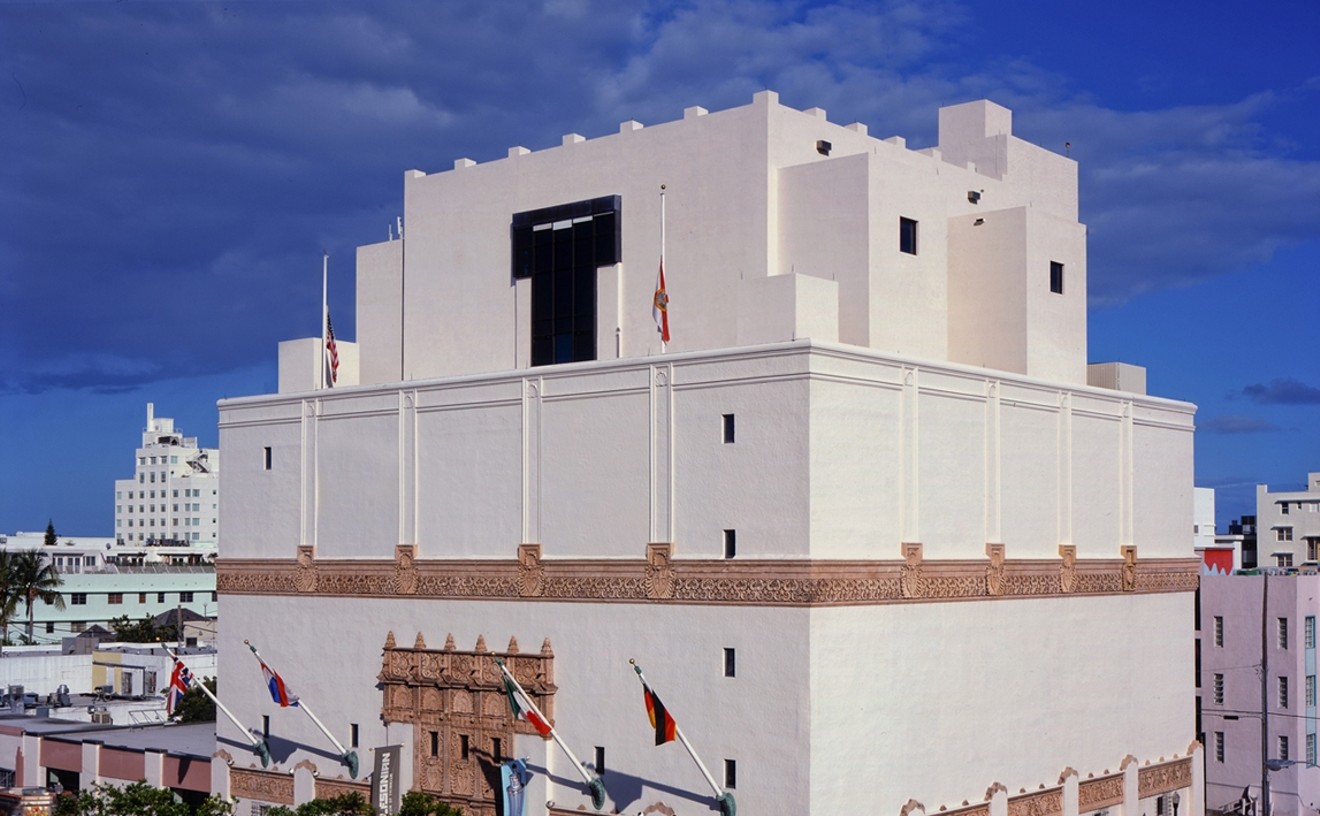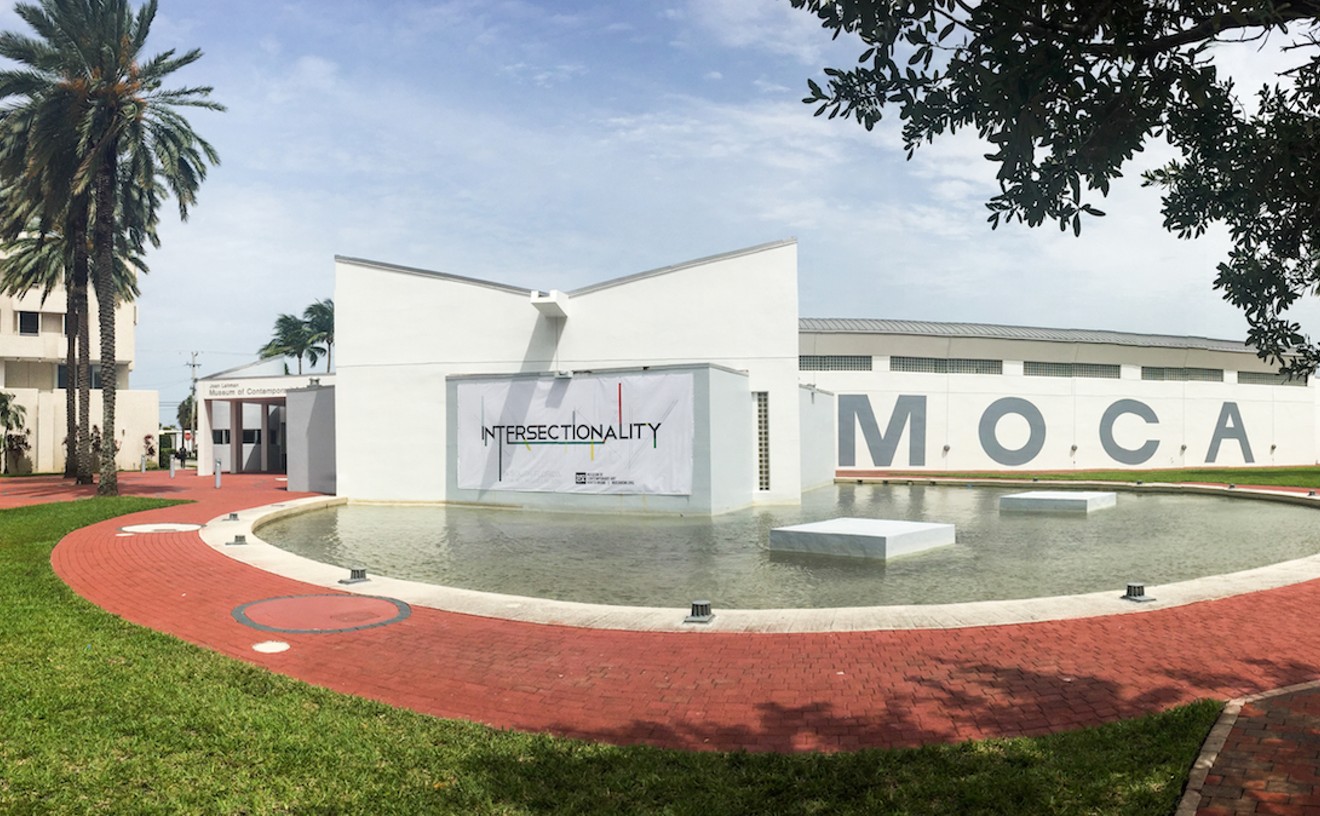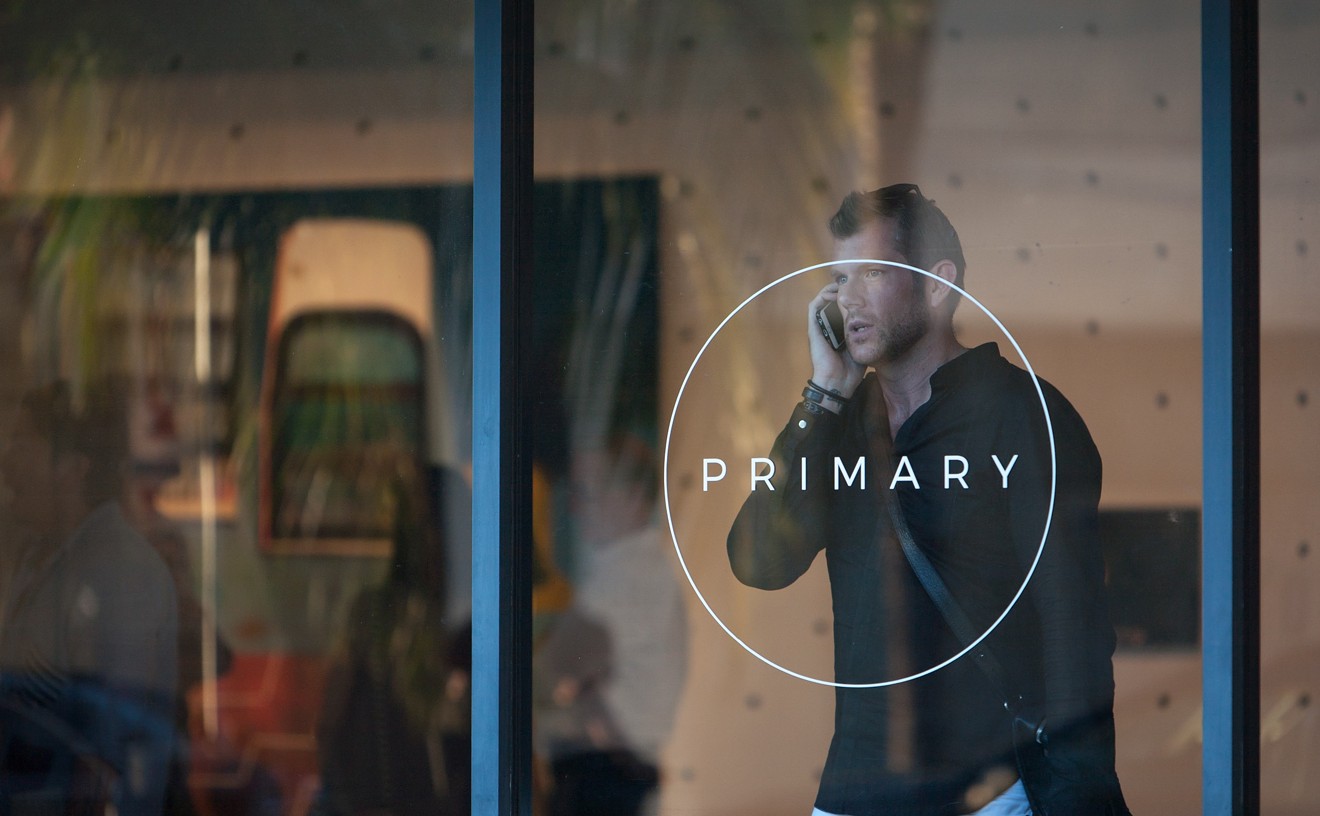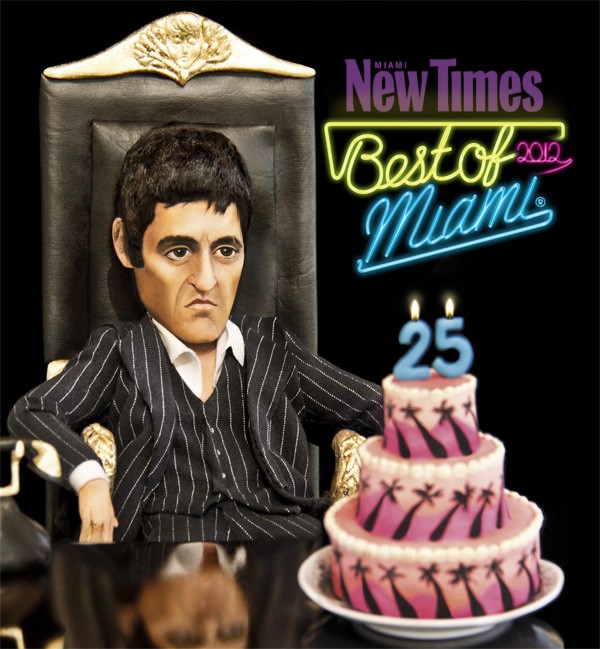Art with an attitude and an uncompromising eye for gritty street swagger distinguishes Primary Projects from the rest of Miami's ever-growing pack of galleries and artist-run spaces. Powered by the triumvirate of BooksIIII Bischof, Typoe, and Chris Oh, this multidisciplinary stage for bleeding-edge work — oddly located in a swank Design District enclave of restaurants and designer shops — has hosted a sizzling string of solo and group shows in the past year that have been among the most controversial and talked about of the 2011 season. Some of the most memorable works included Edouard Nardon's fearsome yet oddly beautiful collection of jailhouse shivs; Scott Shannon's gorgeous Crayola drawing of a swastika floral bouquet; Autumn Casey's petrified, rotten-apple bongs; and George Sanchez-Calderon's bronze crack-pipe sculpture. Those tired of Wynwood's increasingly commercial scene flocked to Primary for a taste of art that fluctuated between the sublime and sinister, from Kenton Parker's fully functioning Taco Shop to Andrew Nigon's surreal Bullwinkle moose head with antlers festooned by what appeared to be rainbow-hued used-car-lot flags. And who can forget Jessy Nite's Hell Here, a brazen one-night stand in which she recruited a stripper to deliver private lap dances to viewers willing to part with their greenbacks. When it came to Art Basel headline grabs, no local space commanded as much attention last December as Primary, which staged Miru Kim's 104-hour performance I Like Pigs and Pigs Like Me, in which the Korean-American artist wallowed nude with two live hogs in the gallery's storefront window, earning tons of international media attention while stirring controversy with animal advocates.
Best Art Gallery
Primary Projects
Best Museum
The Wolfsonian-FIU

Let's face it: Miami is not always seen as the classiest town. Many outsiders still think our idea of art is a stripper's Betty Boop tramp stamp. But if Art Basel and the explosion of Wynwood aren't enough to silence the critics, try taking them to one of the most unique and well curated museums in any city. The Wolfsonian, which was born from a collection belonging to millionaire Mitchell "Micky" Wolfson Jr., is packed with artifacts of modern design, organized in a way that is somewhat random yet cohesive and themed. Creepy German World War I propaganda posters are displayed beside a 1920s zeppelin model, which hangs not too far from an art deco hair dryer. It's like a trip to your uncle's attic, if your uncle collected seminal design work and not foam beer koozies. Spend a couple of hours in this beacon of culture — admission is $7 for adults, with Friday nights free — and then feel free to return to a more stereotypical life of G-strings and beer bongs. Open daily noon to 6 p.m. and Friday noon to 9 p.m.; closed Wednesdays. Seniors, students with valid ID, and children ages 6 to 12 pay $5; Wolfsonian members, children under 6, and students, faculty, and staff of the State University System of Florida are admitted free.
- 1001 Washington Ave., Miami Beach, 33139 Map
- 305-531-1001
- www.wolfsonian.org
Best Art Museum
Museum of Contemporary Art

Celebrating its 15th anniversary, the Museum of Contemporary Art has always had a mission to inspire cultural consciousness among local audiences — the younger the better. Museum director Bonnie Clearwater is a firm believer in arts education and has expanded MOCA's outreach programs to include a museum-studies partnership with Miami-Dade County Public Schools, directly affecting more than 7,000 students in kindergarten through 12th grade. The museum also operates an after-school junior docent program in which students guide peers on tours of exhibits and take journalism workshops to learn to write creatively about art. But Clearwater has also made a name for herself with an eye for discovering fresh talent and giving many rising Miami artists their first museum shows. To date, she has screened the works of more than 200 locals in MOCA's celebrated festival, Optic Nerve. Also, the museum typically draws young families to enjoy free jazz concerts on its lawn every month and consistently mounts some of the most provocative and fresh exhibits during each season. Last year's blockbusters included Mark Handforth's "Rolling Stop," featuring monumental works too large for the museum walls to contain and were exhibited throughout the community, from Griffing Park to Wynwood. Ryan Trecartin's epic series of videos filmed locally, "Any Ever," was a crowd magnet, and MOCA's three-day symposium New Methods, focusing on cutting-edge artistic practices and educational exchange, drew cultural leaders from six countries. It comes as no surprise that Clearwater receives regular letters from former student interns saying that working at MOCA inspired them to pursue art degrees.
- 770 NE 125th St., North Miami, 33161 Map
- 305-893-6211
- mocanomi.org
Best Acting Ensemble
Cast of So My Grandmother Died, Blah Blah Blah
Overflowing with pop cultural and Wikipedia references, textually dense psychodrama, and existential meanderings, Mad Cat's So My Grandmother Died, Blah Blah Blah was a theater experience that can be described only as tripping balls while journeying through the mind of a girl suffering from severe writer's block. This original production was an amalgam of fascinating characters, a daring story line, and well-timed Oprah jokes, and it took a remarkably talented cast to bring home the crazy. Melissa Almaguer was hilarious as the whirling, harried, emotional hot mess Polly, the Alice of this Wonderland working out her writer's block while dealing with her personal romantic pitfalls and the death of her grandmother. Polly's mind was a minefield of subconscious voices and personalities that came in the form of three "deconstructionists" who were her own personal Greek chorus, played with disturbing brilliance by Troy Davidson, Anne Chamberlain, and Ricky Waugh. The trio hysterically morphed from one personality to another, frantically feeding the audience a healthy dose of information about an eclectic array of subjects via monologues and soliloquies, all while Polly navigated the uproariously convoluted story with her dry wit. In a kinetically paced mind-zonk of a play where comedic timing was everything, no other cast brought it harder — and crazier — than Mad Cat.
Best Art Walk
Art + Design Night
Forget the circus atmosphere of Wynwood's Second Saturdays. A few blocks north, on the same second Saturday of every month, the Design District hosts a much more subdued art walk that's every bit as interesting. What makes this one special is that instead of the wafting smell of fried dishes from food trucks, you have your choice of lauded eateries such as Michael's Genuine Food & Drink (130 NE 40th St.), Sra. Martinez (4000 NE Second Ave.), and Egg & Dart (4029 N. Miami Ave.). Oh, and let's not forget the art. Galleries such as 101/Exhibit (101 NE 40th St.), Bas Fisher Invitational (180 NE 39th St.), Locust Projects (3852 N. Miami Ave.), Primary Projects (4141 NE Second Ave.), FriendsWithYou (3930 NE Second Ave.), and the De la Cruz Collection (23 NE 41st St.) call the area home and exhibit some of Miami and the world's best artists. Parking is plentiful if you arrive early, but beware: Leaving your vehicle in the historic Buena Vista area, which has residential parking only, can spoil your night of art and food by having to pay a visit to the tow yard. If you get there after 8 p.m., hit up one of the four valet stations throughout the district for a measly $3.
Best Basel Headline Grab
Yishay Garbasz
From a drug-filled coffin at a satellite fair to a naked artist lying in the mud with a pair of hogs in a local gallery window, the tenth-anniversary edition of Art Basel featured plenty of weird art to compete with the high-priced masterpieces at the Miami Beach Convention Center. But if there was one artist this past December whose opus raised the bar on headline grabbing, it was Yishay Garbasz's cringe-inducing installation at the Seven Art Fair. The Israeli-born, Berlin-based artist typically explores issues of gender in her work. At Seven, the Bard College-educated photographer presented an arresting suite of self-portraits snapped over the course of a year documenting her gradual transformation through surgery and hormone treatment from man into woman. The powerful pictures, exploring a typically taboo subject, were visceral and compelling in their honesty. But what left tongues wagging was the artist's display of her post-op testicles floating in a jar.
Best Alternative Art Space
6th Street Container
Nestled behind a building housing a barbershop, bakery, dollar store, and tattoo parlor, the unusually configured 6th Street Container has become a hotbed of provocative exhibits far from Wynwood's increasingly commercial spaces. Since opening the space about two years ago, chief curator Adalberto Delgado and director Maria Amores have organized a steady stream of monthly shows featuring seamlessly curated solo and group exhibits notable for their unexpected, experimental nature. This past season, some of the indie art house's offerings included Cat Del Buono's "Vanity Unfair," which skewered the Magic City's obsession with unattainable notions of beauty, and Alma Leiva's En la Celda (Inside the Cell), a site-specific installation evoking political terror in Honduras. For their project "Dome Drift," a cerebral work by the collaborative team of Cristina Molina and Wes Kline, the duo used both the interior of the 6th Street Container and parts of its sprawling courtyard for their exploration of Buckminster Fuller's geodesic dome and its enduring impact on culture and architecture. Last year, the modest Little Havana space was a Knight Arts Challenge finalist for its efforts to promote established local, national, and international artists outside the mainstream, as well as crackerjack emerging talent. Look for the 6th Street Container's initiatives to host international exchange programs, artists' residencies, and local community workshops.
Best Art Curator
Ruba Katrib
This past February, Miami's art scene lost one of its elite leaders when Ruba Katrib was tapped as the new curator at Long Island City's SculptureCenter. Before leaving the Magic City, Katrib, the former associate curator at the Museum of Contemporary Art in North Miami (MOCA), left an enduring legacy at the museum by organizing a string of exhibits easily rivaling any top-flight cultural institutions in the nation. With an astute eye for talent and of-the-moment art trends and critical contemporary issues, Katrib gained international attention in 2010 when she organized the first U.S. museum survey of the work of Cory Arcangel and introduced South Florida audiences to the Paris-based collective Claire Fontaine. Prior to landing in South Florida, Katrib, a West Virginia native, had earned her bachelor's degree in visual and critical studies from the School of the Art Institute of Chicago and later graduated with a master's degree from Bard College's formidable Center for Curatorial Studies. She went on to found ThreeWalls, a Windy City nonprofit, before moving on to the Centre Pompidou in Paris, where she cultivated an international arts network. Last year, she brought Ryan Trecartin's "Any Ever" to MOCA — hands down one of the top events of the year's arts calendar. She also organized the ambitious group offering "Modify, as Needed" before accepting her new post at the SculptureCenter. Luckily, Katrib, who served as an adjunct professor at the New World School of the Arts, has inspired a fresh crop of talent likely to carry her dynamic vision well into the future.
Best Gallery Exhibit
"The Fabulous Bunny Yeager"

Idolized by several generations for her savory pinups, including the infamous nude photos of Bettie Page that graced the pages of Playboy in its infancy, Bunny Yeager can mark 2011 as the year of her rediscovery. The iconic South Florida shutterbug was the subject of her first museum survey at Pittsburgh's Andy Warhol Museum, where highbrow art swells showered her with some long-overdue love. In Miami, her modest solo, "The Fabulous Bunny Yeager" at Harold Golen, was the first gallery exhibit featuring Yeager as the subject. The tantalizing show featured a luscious collection of rare, never-before-seen self-portraits taken by Yeager during the '50s and '60s. Not only did they quickly become the toast of the town, but the former beauty queen's enduring allure also earned her a spot on New Times' May 5, 2011 cover. Not surprisingly, Yeager's work caught the eye of Berlin-based curator Helmut Schuster, who organized a blockbuster exhibit boasting more than 200 of her eye-scalding pictures this past Art Basel.
- 2294 NW 2nd Ave., Miami, 33127 Map
- 305-989-3359
- www.haroldgolengallery.com
Best Art Fair Meltdown
ArteAmericas
For lovers of traditional and contemporary art from Latin America, ArteAmericas has become a darling by mixing big names such as Wifredo Lam and Carlos Cruz-Diez with emerging talent from around the hemisphere. The self-described "boutique fair" typically draws about 50 international and local galleries to the Miami Beach Convention Center, where visitors can discover more traditional museum-quality paintings and sculptures alongside the latest trends in multimedia and video installations. But in 2011, the fair tried spicing up its image with racier works such as dancing dildos and videos of swollen, glowing testicles courtesy of the Wynwood art space LMNT. Although crowds flocked to LMNT's stall to peek into a gold-painted mannequin's backside and observe themselves emerging through its digestive tract in one interactive opus, ArteAmericas' ninth installment soon turned excremental. During the weekend, a vandal scrawled the word shit on local artist Marco Vallela's series of abstract paintings, valued at $8,000. The paintings were removed from the exhibit after Miami Beach police investigated. Then ArteAmericas was in the news again for all the wrong reasons after Cuban painter Agustín Bejarano, who was in town exhibiting at the fair, was busted by Hialeah cops for allegedly sexually assaulting a 5-year-old boy. Let's hope 2012 puts the fair back on its path of celebrating the highlights of Latin American arts.






